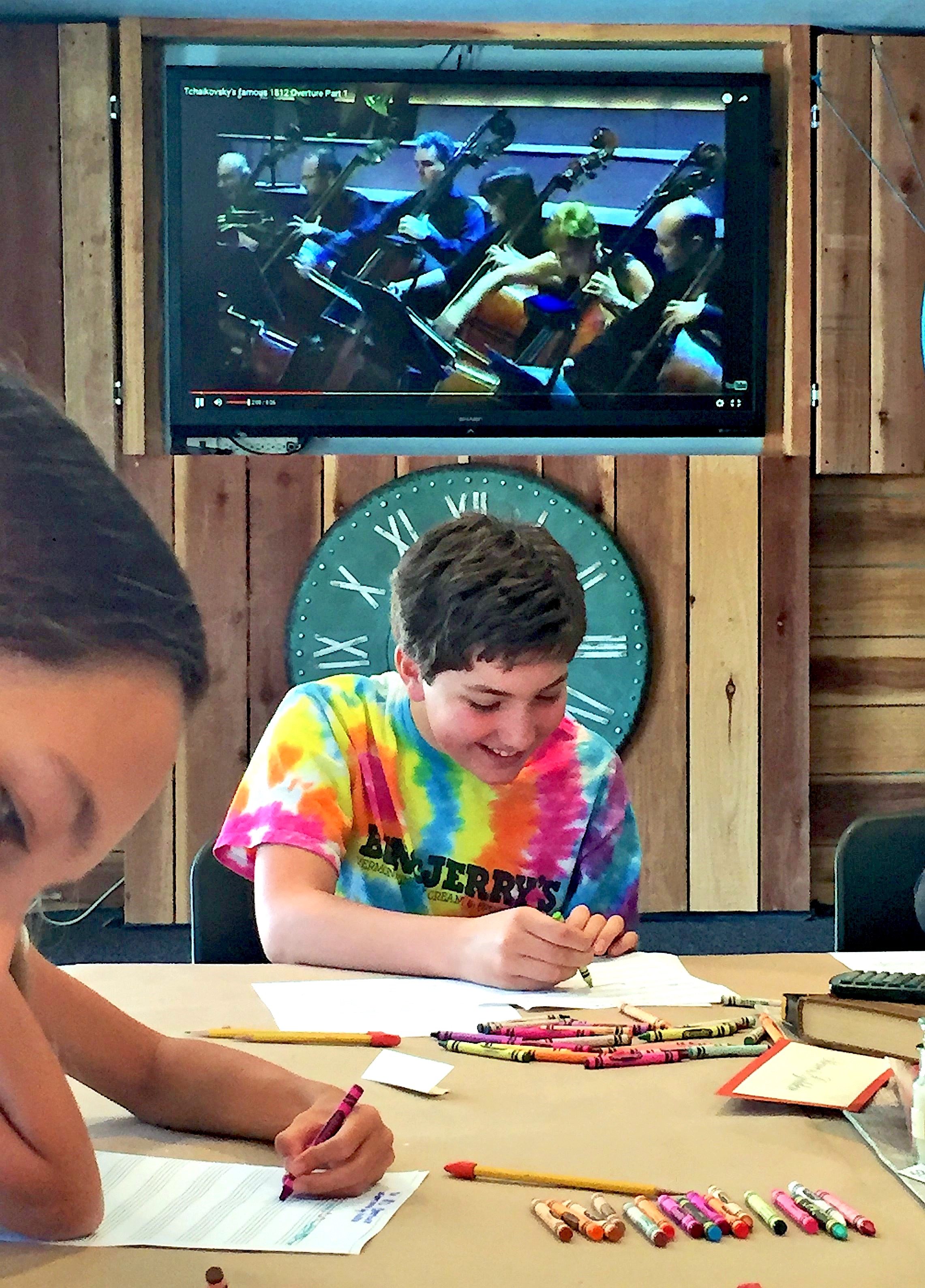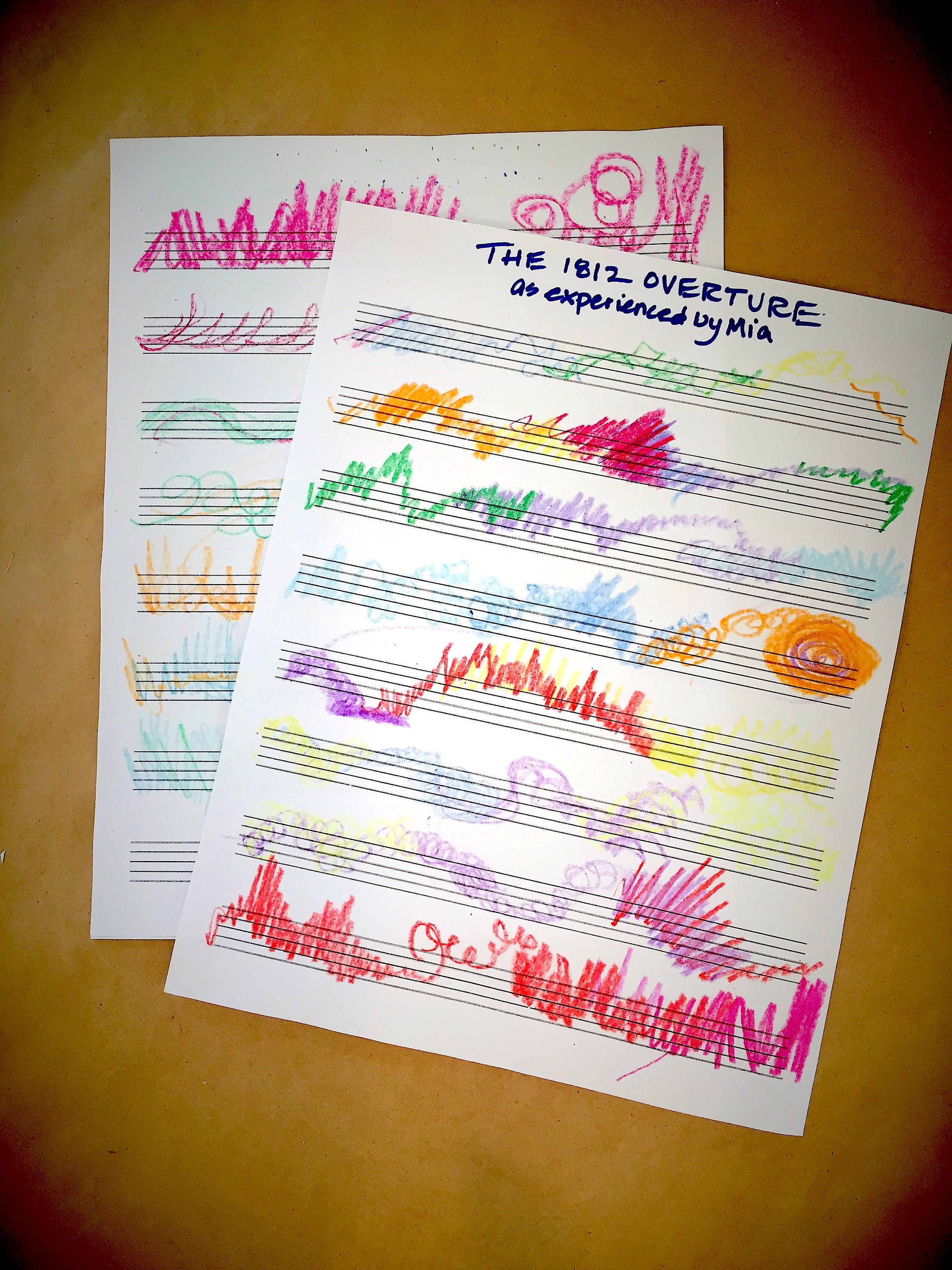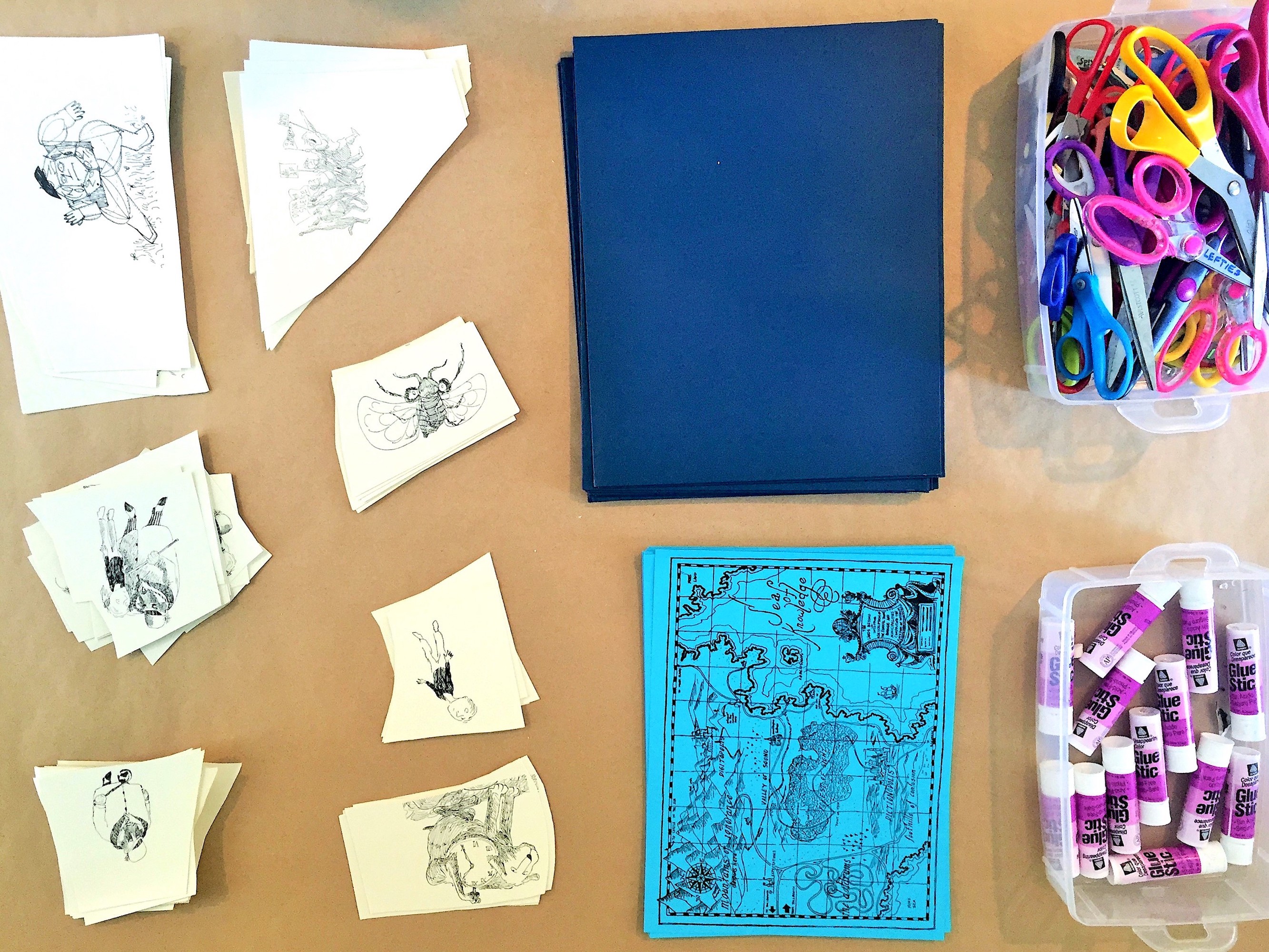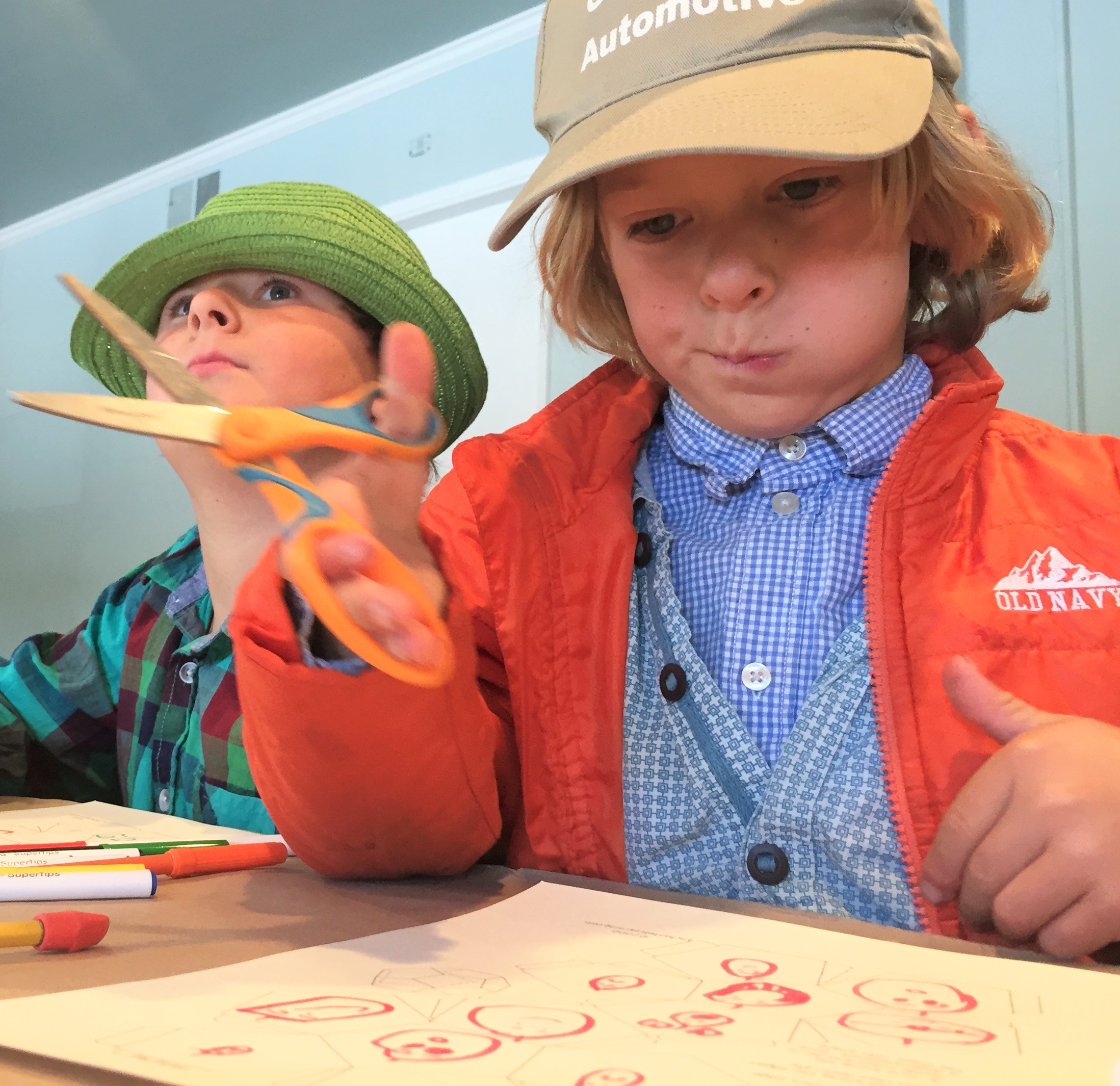Creative Teaching Resources for
by Norton Juster (1961)
Plus: Takeaway Topics, Learning Links, and Prop Ideas
When a tollbooth mysteriously shows up in Milo's room, he only drives through it because he's bored—as he ALWAYS is. But when he emerges on the other side, some very unboring adventures await him. He jumps to the Island of Conclusions, then learns about time from a ticking watchdog named Tock, and even rescues Rhyme and Reason! The Phantom Tollbooth is a fun, easy read—but it’s densely packed with hilarious wisdom. It gently drives home the value of education—and the joy of life.

ACTIVITIES ON THIS PAGE:
Meet the author
Eat your words!
Compose a Chromagraph
Make people from puns
Guess what's making that noise
Release the Dynne
Act like an idiom
Be a Silencekeeper
Honor Norton & Jules with their own art
Be Jules Feiffer
Crunch some numbers
Face the Dodecahedron
Review plot points on the narrative arc
Just(er) for fun
ON THIS PAGE:
Printables: preview of worksheets and activity printables for sale
Takeaway Topics: teaching points made meaningful through activities
Prop Ideas: story objects that make abstract ideas more memorable
Learning Links: curated external links for lesson prep or tangential learning
Shareables: graphics of key ideas
Great Quotes: some favorite lines to discuss
Terms of Use: how you may use LitWits® resources
LitWits makes a small commission on anything you buy through our Amazon affiliate links, at no additional cost to you.
Creative Teaching Idea #1
If Norton Juster hadn't been born, neither would Milo and all the other characters in The Phantom Tollbooth! Introduce your kids to the author through this short video, which shares kid-friendly, interesting aspects of his life (this clip start at 1:42).
You’ll find a worksheet for author note-taking and conversation-starting in our printables set.
Creative Teaching Idea #2
Set up a booth at the Dictionopolis Word Market, and "sell" an assortment of goodies. Choose to accept whatever currency you'd like to collect—homonyms, synonyms, homophones, or our favorite, PUNS! You might offer Aunt Faintly Macabre’s sugar-coated punctuation marks, and some synonym buns from the royal banquet. Rigamaroles and ragamuffins are other fun options, and cheesy half-baked ideas are always just a little too popular for our taste, so to speak. Sell DIY letters and have the kids describe how they taste. Is X really stale? Is Z sawdusty? Is C extra crispy and crunchy? There are so many delicious ways to eat your words!
If you'd like to package up individual BookBites for your kids, you might like our fun labels for wrapping synonym buns and punctuation marks, shown here. (The box wrapper fits around a little box of Nerds, which we word nerds found quite appropriate as punctuation marks.) You can also stash the "word market" letters in each bag, as supplies for the Norton & Jules activity.
(Food signs below are not included.)
Creative Teaching Idea #3
We can’t blame Milo for trying to conduct the sunrise – who wouldn’t want a chance to orchestrate such colors? We all love the idea of conducting color as if it were sound. You can play with that idea a little, and have the kids compose a conductor’s sound in color!
This activity allows kids to thoughtfully interpret one art form into another, in a way that not only demonstrates but engages them in the personal, individual meaning of art. They feel the pleasure of responding to art, and of simultaneously creating art themselves. Because it’s “guided” by existing music, it’s not intimidating for anyone.
loose assorted crayons piled in front of each child
a stack of staff paper for each child, included in our printables

Tip: You might want stacks of extra staff paper within easy reach, as some kids’ compositions are much longer than others--it all depends on how they “see” the sound!
1. Read the description of Chroma the Great as he conducts and concludes the sunset. (If you have an extra few minutes, you might want to share what a conductor does.) Then tell the kids they get to play Chroma the Great — but instead of creating color in the sky with musical instruments, they’ll recreate music on paper with color instruments.
2. Pass out the staff paper and have the kids write the title of the music and their name at the top.
3. Explain that they’re going to listen to another conductor’s music, and translate what they hear into color. They’ll want to listen deeply and thoughtfully, grabbing whatever crayon (or multiple crayons) seem the color of the sound at the moment. The color will change very often! Sometimes they’ll want to compose with two crayons at once.
Color won’t be their only way of expressing the music, either. Sometimes the color will be pressed down dark and sometimes hardly at all. It can run high or low on the staff, continuous or separate in places, swirly or speckled or loopy or sharp or wavy or jagged or flat. It will probably be ALL of those things at one point or another! The color and the way it is colored will depend on the sound — and how the listener hears it.
Put the kids at ease about the “no wrong way” nature of this. It doesn’t matter what the person next to them is doing. The “key” to this musical art is the listener. Each person will hear the same music, and yet interpret it differently. That’s the beauty of art!
4. Play any recording of symphonic music. Here are a few recognizable pieces:
Rossini’s William Tell Overture, Finale 2:05
Rimsky-Korsakov’s Flight of the Bumblebee 3:21
Tizol’s Caravan 3:31
Bizet’s Farandole 3:50
Mozart’s Eine kleine Nachtmusik 6:24
Beethoven’s Symphony No 5, First movement 7:59
Shostakovich’s Symphony no. 5, Allegro non troppo 10:53
Liszt’s Hungarian Raphsody No. 2 11:12

Tip: It’s fascinating to keep an eye on the conductor and orchestra, but also too distracting for some. You might choose to use audio only, or have the kids turn their backs on the screen.

Scroll on for more, or browse other titles.
Creative Teaching Idea #4
Who doesn't love a great pun? For that matter, the worse the better. Have your kids create their own characters out of puns, Norton Juster style.
Start by having them come up with pairs of homophones like "cellar/seller," "reign/rain," "bare/bear," etc. Use that list to find familiar phrases, like "storm cellar" or "light rain" or "bare minimum."
Then turn those phrases into people or creatures, with a little more detail for fun. For example:
The Storm Seller sells thunderclouds to kings who reign over dry kingdoms.
The Bear Minimum is a tiny lazy bear from Justenuff.
We could go on . . . really, we could. But you get it—and if you'd like a worksheet that spells this out for your kids, you got it.
Creative Teaching Idea #5
Dr. Dischord’s delight in noises is infectious. In “echoing” his unique descriptions of the sources of noises, kids are thinking about cause and effect relationships, stretching their imaginations, and picking up on Norton Juster's creative writing skills. This fun activity is easy and free—just play some weird sounds (in the dropdowns below) and let the kids guess what's causing them!
They will, of course, hear MUCH better if they're wearing a pair of Dr. Dischord ears. You'll find those in our printables set, just waiting to be cut out and taped to a plastic headband. HAVE FUN!!!
1. Read aloud the three “Have you ever heard?” questions Dr. Dischord asks Milo in “Dischord and Dynne,” about the slippered ant, blindfolded octopus, and square-wheeled steam roller.
2. Tell the kids they’re going to hear some strange sounds and identify their causes creatively, beginning with “Have you ever heard?” just like Dr. Dischord. Warn them that they’ll be tempted to name the literal sound (the effect), when what we want is the imaginative source (the cause). Not “that’s someone breaking glass!” but “Have you ever heard a hundred elves hacking icicles off the eaves of Santa’s workshop?”
3. Then play some recorded or online sounds. Here are a few suggestions from Freesound:
stirring macaroni and cheese water sloshing in the bathtub a squeaky cupboard door a pig grunting walking in leaves
Scroll on for more, or browse other titles.
Creative Teaching Idea #6
Everyone loves the Awful Dynne, Dr. Dischord's assistant and noise collector! This activity gives kids a chance to do his job, stretching their imaginations and listening skills as they attach words and sounds to what actually makes that sound.
Give each child a bag of empty plastic test tubes straight from the good doctor's lab, as proven beyond a doubt by the label (in our printables set). Then set the kids loose to collect noises—desk drawers and kitchens make great sound quarries—and label the sounds for Dr. Dischord.
You can approach this "translation" activity from two directions. First, have the kids find things that make the noises on our premade labels (or make your own)—these are noises Dr. Dischord has asked the Awful Dynne to collect. What items would result in Swish sounds? Snaps and Crackles? Soft Cries? What collection of odds and ends would create Misc. Uproar?
Then, after they've collected new noises, reverse the instructions. Instead of looking for noises to fit words, now they had to find words to fit noises, and use the blank labels to identify the sounds for Dr. Dischord.
Creative Teaching Idea #7
Norton Juster uses or alludes to a lot of idioms, words that don't mean what they literally say but are used to make a point. Kids will hear idiomss the rest of their lives, so enhance their cultural savvy by helping them understand some common ones. For instance:
don't count your chickens until they're hatched
once bitten, twice shy
don't make a mountain out of a molehill
make hay while the sun shines
lots more right here
Then ask for volunteers to act out their favorites. The rest of the class should call out "Break a leg!"
(If you'd like your kids to work out some idioms on paper, we've got a worksheet for that.)
Scroll on for more, or browse other titles.
Creative Teaching Idea #8
All teachers and parents can relate to the Soundkeeper’s reverence for silence, and her appreciation of the different kinds! Kids can, too. This quiet activity teaches them to notice and discern, and to express that discernment creatively. You can choose to have them verbalize or write their responses.
Ask the kids to be perfectly quiet and identify the type of silence they’re creating. Is it an expectant hush, a nervous tension, or merely a lull in the laughter? Then ask them to describe the way they feel in the silence that follows these moments:
you’ve just woken up, and it’s still dark outside
your mom or dad has just called you by your full name, in a serious tone
it’s been pouring on the roof of your house, and the rain very suddenly stops
you’re in a parking lot, and you hear a screech of brakes
you and your friends have been laughing so hard you cried, and the last laugh has just trailed off
you’ve just removed the lid from a gift box, and what’s inside is horribly disappointing
Creative Teaching Idea #9
Part of the appeal of this story is its fantastic illustrations. As Maurice Sendak says in his 1996 “Appreciation” for this book, not many artists are able to draw ideas. This project honors Jules Feiffer’s ability to make a threadbare excuse or an awful din something we can see.
We celebrate Norton Juster here, too, by recreating his title. Doing so with mismatched letters bought at the “Word Market” lets kids experience a key scene. (There's an alternative, similar project below.)
We wish these two talented men were still with us, but are grateful they left us their inspiring arts. To respect their copyrights, the endpapers and illustrations aren't included in our printables set.

colored pencils
scissors and glue
3-D foam squares (like these)
magazines for finding letters and words (or a pre-stocked Word Market, shown below
pocket folders, if using (we use them to store worksheets)
copies of the map from the endpapers, printed on blue cardstock – one for each child
multiple copies of various story illustrations, printed on white cardstock and separated into piles (to respect the copyrights, we're not providing downloads of the map or illustrations)
Have the kids look through magazines to find letters to form the book’s title. If you’ve pre-stocked a Word Market, or are helping them search, tell the kids to shop wisely – these letters are "used" but have been specially curated by you, and can be had for a synonym or a cliche (or a pun, idiom, or homophone). Kids have fun coming up with this currency.

After they’ve glued the title to the map, tell the kids to choose 2-3 of their favorite illustrations. They should color the pictures, then cut them closely and attach them to the map with the 3-D squares to make them pop out.
While the kids work, you might show them these clips about the author and illustrator, Milo’s BFF Tock, and the obnoxious Humbug.
Scroll on for more, or browse other titles.
Creative Teaching Idea #10
In this alternative activity honoring the late Jules Feiffer, kids get to try their hand at making his clever, scratchy characters. But first, to make this a drawing AND "wording" activity, have them cut up the title letters in our printables set (or from magazines), and mix them up.
Ask them to make as many words as they can from those letters, keeping a list. You can use a timer to pick up the pace, or let them take their time. (Sorry, Tock!) You can turn it into a contest, or let it be a thoughtful exercise. When they're done with that wordplay, have them glue the letters at the top of our template (or a piece of white card stock) to correctly spell the title.
Finally, have them emulate a favorite Jules Ffeifer's iilustration under the title. Here's a video we made to help walk your kids through that process:
You might want to also give the kids 2-3 minutes to draw an idea not pictured in this book. What would Jargon say and do? What would Nostalgia look like? Here’s a list of abstract nouns for more ideas!
Creative Teaching Idea #11
The half-child (.58, actually) teaches Milo about averages, which is a good concept to teach your full-size kids. Averages are so useful for figuring out what to expect, or how to plan ahead!
For instance, let’s say Milo is throwing himself a “welcome home” party, and wants to serve all-you-can-eat juice popsicles. He’s going to invite all 20 of his classmates, but he knows some kids might not eat any, some might eat one or two, and a few might eat a LOT more than that. He’s asked his five cousins how many juice popsicles they would eat if they got the chance, and he’s written down their answers.
All YOUR kids have to do is give the cousins some silly names, add up the total, divide by 5 to get an average, then multiply that average by 20 classmates to find out how many popsicles Milo should freeze for his classmates. (That's extra easy to do on our worksheet.)
Scroll on for more, or browse other titles.
Creative Teaching Idea #12
Lacking Tock’s math skills, we know for a fact we’d never have made it to Digitopolis without the Dodecahedron. This project teaches a little Latin, a geometry idea, and the concept of silent communication. We’re always sending a message — whether we speak up or not!
Read the description of the Dodecahedron, then tell the kids they get to make one that will say at least twelve things without speaking a word!
When they’re finished, tell them to practice making (with their OWN faces) each expression they’ve created! Our kids had fun rolling their dodecahedrons like dice, then trying to replicate the expression that landed “face up”.

The dodecahedron template is in our printables set.
scissors and tape (tear off tape strips ahead of time, and line them up on the edge of a table or desk)
dodecahedron template, included in printables
expressions to copy, included in printables
1. First, talk about the definition of dodecahedron. Tell the kids that dodeka is Greek for twelve. (You can break this down further by pointing out that duo means two, and deca means ten, as in decade.) Hedron comes from the Greek for “the face of a geometric solid.” A dodecahedron, then, is a twelve-faced geometric solid.
2. Next, talk about the different expressions the Dodecahedron wore. Ask the kids how many they can name beyond happy, sad, and angry, then ask them to draw twelve faces on the template form. (Here are some examples, if they need prompting. There's also a sheet of cartoon expressions in our printables set.)

3. Have the kids carefully cut out the whole shape, being careful not to cut off the tabs. This part can seem kind of daunting, but it’s doable if they take it slowly!
4. Fold the tabs back and bring each pair together, then tape across the front (on the outside). The taping will be easier if they work with a partner – one holds the two edges in place, the other does the taping.
Here's a little video you can show the kids:
Creative Teaching Idea #13
Help kids learn the important concept of story order (useful for all communications!) and see how Norton Juster arranged The Phantom Tollbooth. You can discuss and/or do our narrative arc worksheet in any of these three ways:
At the end of your activities, introduce the concept of the narrative arc, then help kids figure out where the different parts of this story fit on it.
OR introduce the concept and complete the worksheet before the activities, so kids have a review of the story fresh in their heads first, and you can remind them "where we are" on the arc as you go.
OR introduce the concept up front, but save the story's scenes to discuss as you go, pausing to "do what the characters did" in fun hands-on ways, while weaving in discussions and other worksheets.
Creative Teaching Idea #14
When you're done teaching and experiencing The Phantom Tollbooth, give each of your kids a blue envelope containing a copy of the note Milo received at the end of the story, and seal the envelope with a Tockish sticker.
This is for fun but also to remind the kids that they KNOW THE WAY to educate and entertain themselves, and need never be bored (or boring) for long!
You're off to share the best of this great book in fun, hands-on ways!
If you'd like the two of us (Becky and Jenny) to teach your kids, check out our video workshop! The necessary printables are included with your purchase. You print those and gather the supplies, and we'll do the teaching.
It's helpful to know this book's big teaching points ahead of time, and explore some fascinating links to add to your lessons. Read through these Takeaway Topics, then explore the supportive Learning Links below them. Make notes as you go, so you’ll remember what you want to share, and when.
Our worksheets and activity printables connect to these key ideas, and so do the Prop Ideas below this section.
Takeaway 1
The joy of wordplay dominates this book, even in Digitopolis! Puns abound, and in a variety of forms. The first step to getting these jokes is to know the original words and phrases, and be aware of double meanings. This knowledge is essential to social, school, and job success--wordplay is all around us, and it’s no fun to be in the dark or put your foot in your mouth! The more connotations kids know, the better they’ll be able to read between the lines, and be privy to allusions, too.
Takeaway 2
The main conflict in the story is boredom, or, more importantly, Milo’s failure to appreciate life. But, kids might say (or just think) — isn’t “education” boring? Certainly not the way Norton Jester does it, and not the way Miles embraces it as he travels. The author himself was a man who used (and filled) both sides of his brain, a creative person who worked in a structured field, as an architect. We need numbers and letters constantly — they're never really separate in anything we do. If we open our minds like Milo, the world is twice as rich, and half as full of cheesy, half-baked ideas.
Takeaway 3
Norton Juster describes abstract ideas in ways that make them easy to visualize: a Gross Exaggeration is truly gross, with rows of teeth for mangling truth; the Humbug actually jumps to Conclusions by making a decision without a good reason. But Jules Feiffer’s scribbly-style art makes these abstract ideas even easier to "see" (and inspires kids to try it themselves). Together Norton and Jules, who were friends and neighbors, manage to make invisible concepts into very visible characters.
The Phantom Tollbooth is chock-full of wonderful topics to explore—from etymology to the two halves of the brain to the archetypal hero's quest. Scroll down to see our curated Learning Links for more tangential teaching opportunities.
A table of props pulled “straight from the story” can lead to all sorts of wonderful discussions and wide-eyed, “aha!” moments.
Like these kids, daring to open up The Awful Dynne . . .
Props that are unique to the setting help kids understand “what that was like,” and props that are symbolic of takeaway topics make big ideas visual and tangible. As you read, keep an eye out for items from the book you might like to collect and share, and ask your kids to do the same. You’d be surprised how many things might be hiding in plain sight. Grandparents, garages, attics, and junk drawers sometimes yield the greatest treasures.
Here are a few prop ideas for this book.
You're literally on our page about inspiring kids to love great books. YAY! We're eager to share our passion for LitWitting and the work we've been doing ever since 2010.
We're also eager to keep doing it! :) So if you've found this page. inspiring and useful, please share it with your social world. And if you buy our printables for this book, thank you. We appreciate you helping us keep the lights on at LitWits!
Happy teaching,
Becky and Jenny
Sisters, best friends, and partners